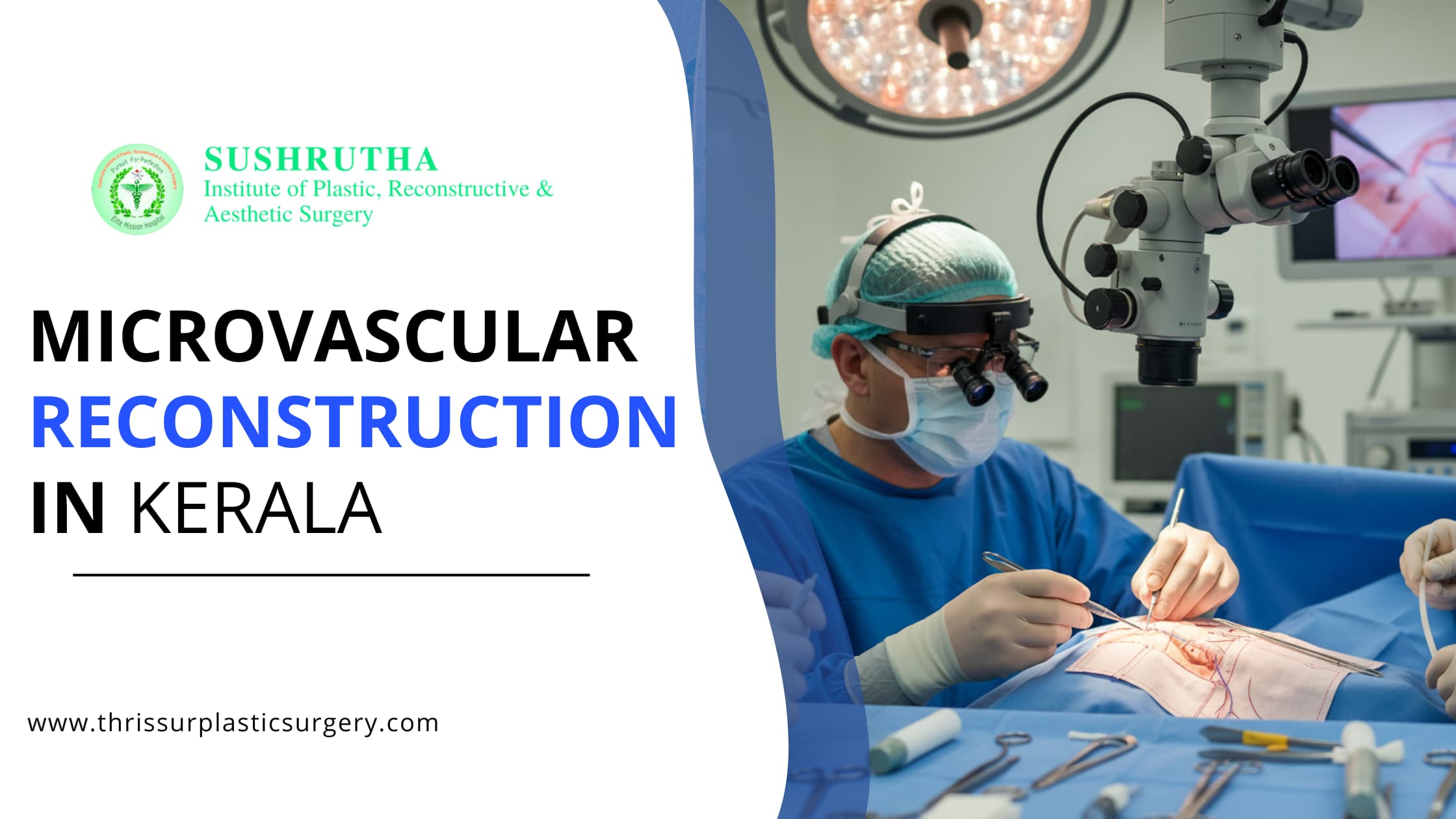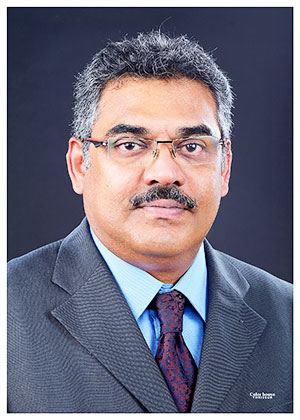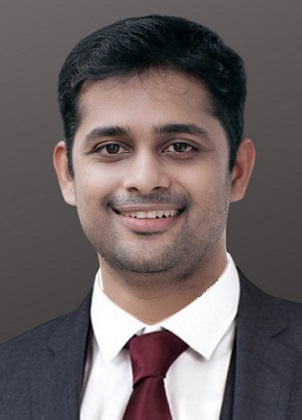When trauma, cancer surgery, or congenital deformities result in complex tissue loss, restoring both appearance and function becomes a medical challenge. This is where Microvascular Reconstruction — one of the most advanced branches of reconstructive plastic surgery — plays a vital role.
At Sushrutha Institute of Plastic Surgery, Thrissur, microvascular reconstruction is performed with world-class precision and care, combining surgical expertise, advanced microsurgical technology, and compassionate patient management. This highly specialized procedure restores form and function by reconnecting tiny blood vessels and nerves — helping patients regain their quality of life.
What Is Microvascular Reconstruction?
Microvascular reconstruction (also called free flap surgery) involves the transfer of tissue — skin, muscle, bone, or a combination — from one part of the body to another. The transferred tissue, known as a “flap,” includes its own blood supply, which the surgeon reconnects to recipient vessels at the reconstruction site using microscopic techniques.
These procedures require surgical magnification, specialized instruments, and advanced microsurgical skills. The result is a restored structure with natural appearance and improved functionality — often in areas like the face, jaw, limbs, or breast after major surgery or trauma.
Why Choose Microvascular Reconstruction
Microvascular reconstruction is often considered the gold standard in complex reconstructive surgery because it offers:
Restoration of both form and function
Use of the patient’s own tissue, reducing rejection risk
Durable, long-term results
Better aesthetic and functional outcomes
Ability to reconstruct large, complex defects
At Sushrutha Institute, surgeons combine art and science — meticulously recreating natural anatomy and achieving the best possible physical and emotional recovery.
Common Conditions Treated with Microvascular Reconstruction in Kerala
| Condition | Microvascular Reconstruction Purpose |
|---|---|
| Cancer Resection Defects | Reconstructs tissue after removal of head, neck, breast, or soft tissue cancers |
| Traumatic Injuries | Restores limbs, hands, or face following accidents or severe trauma |
| Congenital Defects | Corrects developmental abnormalities like cleft defects or missing structures |
| Post-Infection Defects | Replaces tissue lost due to infection or necrosis |
| Non-healing Ulcers or Wounds | Improves blood flow and tissue health for better healing outcomes |
Each case is unique, requiring individualized planning and precision reconstruction to restore both function and aesthetics.
Types of Microvascular Free Flaps Used at Sushrutha Institute
Different types of flaps are used depending on the defect’s location, purpose, and required tissue type.
| Flap Type | Tissue Used | Common Applications |
|---|---|---|
| Radial Forearm Flap | Skin, fascia | Head and neck reconstruction, oral cavity defects |
| Fibula Flap | Bone, skin | Jaw and facial bone reconstruction after cancer surgery |
| Anterolateral Thigh (ALT) Flap | Skin, fat | Versatile soft-tissue coverage for limbs or trunk |
| Latissimus Dorsi Flap | Muscle, skin | Breast reconstruction or large wound coverage |
| Deep Inferior Epigastric Perforator (DIEP) Flap | Skin, fat from abdomen | Breast reconstruction with natural appearance |
| Gracilis Flap | Muscle | Hand, foot, or genital reconstruction |
Each flap requires microvascular anastomosis — precise connection of arteries and veins under a high-powered microscope — to ensure tissue survival and healing.
How Microvascular Reconstruction Works
1. Preoperative Planning
Before surgery, detailed assessments are performed:
Clinical evaluation of the defect and donor site
Imaging (CT Angiography or Doppler study) to identify suitable vessels
3D planning for bone and facial reconstruction
At Sushrutha Institute, every plan is tailored using multidisciplinary input from reconstructive surgeons, oncologists, orthopaedic specialists, and anesthesiologists.
2. Surgery
Tissue is carefully harvested from the donor site with its blood vessels.
At the recipient site, damaged or missing structures are reconstructed.
Using an operating microscope, the surgeon reconnects vessels as small as 1–2 mm in diameter using ultra-fine sutures.
The new tissue is shaped and secured, restoring both structure and appearance.
3. Postoperative Monitoring
Post-surgery, blood flow through the flap is monitored continuously using Doppler ultrasound or clinical observation. This ensures early detection of any vascular compromise and prompt correction.
Recovery and Rehabilitation
Recovery after microvascular surgery depends on the complexity and location of the reconstruction. Typically:
Hospital stay ranges from 7–14 days for flap monitoring and wound care.
Physical therapy starts early to maintain mobility and function.
Most patients return to regular activities within 6–8 weeks.
At Sushrutha Institute, rehabilitation is an integral part of care — ensuring not only survival of the tissue but also restoration of natural movement, sensation, and aesthetics.
Advanced Microsurgical Technology at Sushrutha Institute
Sushrutha Institute is equipped with advanced microsurgical operating suites designed for precision-driven reconstructive procedures.
| Technology | Purpose | Benefit |
|---|---|---|
| Operating Microscopes | Visualizes tiny blood vessels and nerves | Enables accurate microanastomosis |
| Microvascular Instruments | Specialized forceps, clamps, and scissors | Allows delicate tissue handling |
| Doppler Monitoring Devices | Continuous flap perfusion monitoring | Early detection of vascular issues |
| 3D Planning & Printing | Custom reconstruction templates | Personalized, accurate restoration |
| Advanced Anesthesia Support | Stable surgical environment | Safer and shorter recovery |
Such advanced infrastructure ensures the highest success rate for complex reconstructions, matching international standards.
Microvascular Reconstruction vs. Traditional Reconstruction
| Aspect | Microvascular Reconstruction | Traditional Reconstruction |
|---|---|---|
| Tissue Type | Uses patient’s own vascularized tissue | Uses local flaps or grafts |
| Longevity | Long-lasting, stable results | Limited durability |
| Aesthetic Outcome | More natural, better color and texture match | May appear uneven or tight |
| Functionality | Restores both function and form | Often functional limitations remain |
| Flexibility | Can reconstruct large and complex defects | Limited to smaller defects |
Patient-Centered Approach at Sushrutha Institute
The hallmark of Sushrutha Institute is its patient-centered approach. Each patient receives:
Individualized consultation and counseling
Clear understanding of risks and expectations
Emotional support throughout recovery
Postoperative follow-up and physiotherapy guidance
This holistic care model ensures both physical healing and emotional well-being.
Why Kerala Is a Hub for Advanced Reconstructive Surgery
Kerala has emerged as a leading destination for advanced plastic and reconstructive surgery due to:
Highly skilled surgeons with international training
Access to cutting-edge technology
Affordable yet world-class medical care
Supportive recovery environment surrounded by wellness and nature
At Sushrutha Institute, patients from across India and abroad seek advanced microvascular reconstruction for its blend of precision, safety, and compassionate expertise.
Specialized Areas of Microvascular Reconstruction at Sushrutha
1. Head and Neck Reconstruction:
Restoring oral cavity, tongue, jaw, and facial structures post-cancer or trauma.
2. Limb Salvage and Replantation:
Reattaching amputated limbs or reconstructing severely injured hands and legs.
3. Breast Reconstruction:
Using DIEP or muscle-sparing flaps for natural post-mastectomy breast restoration.
4. Post-Traumatic and Defect Reconstruction:
Repairing extensive soft tissue loss following accidents, burns, or infections.
5. Nerve Repair and Functional Restoration:
Reconnecting nerves under microscope to regain motion and sensation.
Benefits of Microvascular Reconstruction at Sushrutha Institute
High success rate with state-of-the-art facilities
Experienced microsurgical team led by expert plastic surgeons
Customized surgical plans for each patient
Comprehensive post-surgical rehabilitation
Aesthetic, functional, and long-term results
The combination of technology, skill, and care makes Sushrutha Institute a trusted name in reconstructive excellence in Kerala.
What is the recovery time after microvascular reconstruction?
Recovery usually takes between 4 to 8 weeks, depending on the procedure type and patient health. Rehabilitation exercises are essential to achieve full functional recovery.
Is microvascular reconstruction safe?
Yes. At Sushrutha, the procedure is performed using advanced microsurgical systems, ensuring high success rates and minimal complications.
What conditions can be treated with microvascular surgery?
Microvascular reconstruction treats cancer-related defects, trauma injuries, limb salvage cases, and congenital deformities requiring tissue transfer.
How long does a microvascular surgery usually take?
The duration can vary from 4 to 10 hours depending on the complexity and area of reconstruction. Sushrutha’s expert team ensures patient safety throughout the process.
Are the results of microvascular reconstruction permanent?
Yes, once the transferred tissue establishes blood supply, the results are long-lasting and typically permanent with proper follow-up care.
Conclusion
Sushrutha Institute stands as a center of excellence in microvascular reconstruction in Kerala, combining innovation, surgical mastery, and compassionate patient care. Through advanced technology and a multidisciplinary approach, Sushrutha helps patients recover not just their appearance but their confidence and mobility too.







